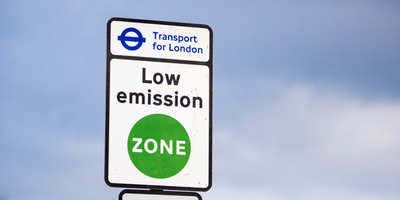Your complete guide to the low emissions zones
What are they and will they affect you?
Back in 2008, the London Low Emission Zone (LEZ) was introduced, to discourage older, more polluting commercial vehicles from driving around the city. As this was more than a decade before the government pledged to ‘be the first generation to leave the environment in a better state than we inherited it’, it was an advanced idea at the time, and one which has grown in popularity (although not with all drivers) in the years that have followed.
In 2019, the LEZ was replaced with the ULEZ, the Ultra Low Emissions Zone. This targeted not just commercial vehicles, but passenger cars as well. Running 365 days a year, any cars that do not meet the emissions standards of Euro 4 for petrol vehicles, and Euro 6 for diesel vehicles, must pay £12.50 a day to drive into the zone.
With a number of changes to the original London zone, new zones in different areas, new terminology for the zones around the country referred to as ULEZ, CAZ and LEZ, and delays in schemes launching, it’s no surprise that we are often asked for the latest news and guidance around these zones.
So, here’s a handy guide to everything you need to know about Low Emission Zones and whether or not you will have to pay the charge.
The evidence from London shows that a clear air zone can reduce toxic air pollution of up to 20%. This was the drop in reduction in air pollution in London between 2019 and 2021. Based on this principle, Low Emission Zones are designed to discourage certain types of vehicles from entering cities or urban areas and are seen as a simple way of tackling levels of urban pollution.
In other areas where air pollution exceeds European legal limits, councils are now encouraged to set up Clean Air Zones, where initiatives including traffic flow measures are being implemented to cut emissions. Although not all Clean Air Zones charge vehicles, it’s increasingly likely that drivers may be charged to enter these in the future. Since 2015, more than 60 local authorities have been tasked with tackling illegal levels of air pollution.
Are you going to be charged?
To help you prepare for Clean Air Zones becoming more widespread across UK cities, you can see if your vehicle will be due for a charge by entering your vehicle’s registration number in the government’s Joint Air Quality Unit online checker to see if you will be charged. If you live in or near London, use the TfL checker instead.
As a quick rule of thumb, any diesel car that doesn’t conform to Euro 6 emission standards (introduced in 2015), and any petrol not conforming to Euro 4 emission standards (introduced in 2005) will incur a charge. So if your diesel was made before 2015, or your petrol car was made before 2005, its worth checking as you may be charged.
These zones are not marked by physical barriers or tool booths, but the charging is automatic and happens via cameras. In London, automatic number plate recognition cameras will detect entry into the zone, and any vehicle movements within it, so there’s no way of avoiding the charge if you drive into or around the zone. Failure to pay will result in a hefty penalty charge notice of £160, which reduces to £80 for prompt payment. To avoid being fined for non-payment, drivers can sign up for automatic charging, which eliminates this risk.
Of course, electric vehicle drivers can breathe a sigh of relief. Not only are all electric cars exempt from ULEZ charges, they are also exempt from London’s Congestion Charge too.
Where are the Low Emissions Zones in the UK?
Although London is leading the way in terms of cutting emissions, Clean Air Zones will likely be coming to a city near you, with schemes already in place or coming soon to: Bath, Bradford, Bristol, Greater Manchester, Portsmouth, Sheffield and Tyneside, as well as Aberdeen, Dundee, Edinburgh and Glasgow.
However, implementation is proving more complex than first thought as concerns have been raised in many cities about the economic impact on lower-income families and workers – this has been seen with the recent protests at the expansion of the London zone.
Bristol City Council delayed launching its clean air zone from October 2021 to summer 2022, primarily to allow for more financial support to enable residents and businesses to upgrade their vehicles to low emission models. Plans for a Clean Air Zone in Liverpool have been put on hold and proposed schemes rejected in Canterbury, Derby and Exeter.
Europe is following suit with more than 200 cities and towns having schemes in place. As travel restrictions ease and thoughts turn once more to driving to the Continent, check where you can drive to avoid paying a penalty.
Driving an electric vehicle is the safest way to ensure that you do not have to pay any charges, enjoy no restrictions and avoid any potential penalties. Tusker is leading the way in providing electric and low emission vehicles for organisations across the UK, while also saving employees and employers money in the process via salary sacrifice. If you switch to an electric vehicle, you can start reaping the benefits right away, not least of which could be a daily saving of more than £10 to drive freely in our cities. With Tusker, you can play your part in cutting emissions while enjoying a brand new car, save money and ensure a brighter future for the planet.
Find out more about going electric with Tusker
